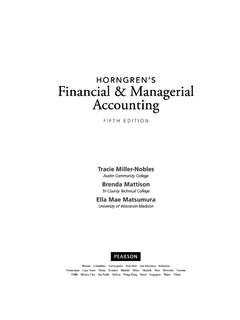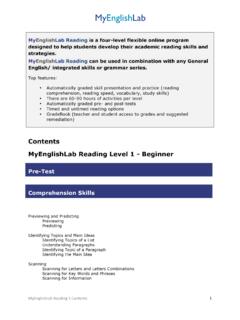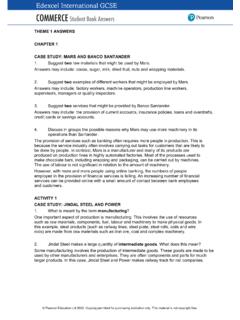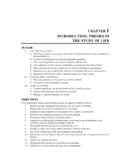Transcription of Evolutionary Patt E rns and Proc E 22 Selection Evolution ...
1 435 natural Selection explains how populations become well suited to their environments over time. The shape and coloration of leafy sea dragons (a fish closely related to seahorses) are heritable traits that help them to hide from PattErns and ProcEssEsunit 4 This chapter is about one of the great ideas in science: the theory of Evolution by natural Selection , formulated independently by Charles Darwin and Alfred Russel Wallace. The theory explains how populations individuals of the same species that live in the same area at the same time have come to be adapted to environments ranging from arctic tundra to tropical wet forest. It revealed one of the five key attributes of life: Populations of organisms evolve. In other words, the heritable characteris-tics of populations change over time (Chapter 1). Evolution by natural Selection is one of the best supported and most important theories in the history of scientific research.
2 But like most scientific breakthroughs, this one did not come easily. When Darwin Evolution by natural Selection22 by applyingby askingby reviewingwith regard tokeeping in mindIn this chapter you will learn that Evolution is one of the mostimportant ideas in modern biologyWhat is the evidence for Evolution ? Evolution in action:two case process of Evolution by natural myths about natural Selection and pattern of Evolution : species have changed and are rise ofevolutionary chapter is part of the Big Picture. See how on pages 516 43512/11/15 2:35 PM436 unit 4 Evolutionary Patterns and Processesshops for manufacturing goods by hand with huge, mechanized assembly scientific revolution, in contrast, overturns an existing idea about how nature works and replaces it with a radically differ-ent idea. Revolutionary scientific theories include Copernicus s theory of the Sun as the center of our solar system, Newton s laws of motion and theory of gravitation, the germ theory of dis-ease, the theory of plate tectonics, and Einstein s general the-ory of relativity.
3 These theories are the foundation of modern advance of the theory of Evolution by natural section rep-resented a profound scientific revolution. The idea that Darwin and Wallace overturned that species were supernaturally, not naturally, created had dominated thinking about the nature of organisms in Western civilization for over 2000 and Typological ThinkingThe Greek philosopher Plato claimed that every organism was an example of a perfect essence, or type, created by God, and that these types were unchanging (Figure ). Plato acknowledged that individuals of a species sometimes varied slightly from one another, but that these were just trivial deviations around a perfect essence. Today, philosophers and biologists refer to ideas like this as typological thinking. Typological thinking also occurs in the Bible s book of Genesis and in the creation stories of many other religions, where a divine being creates each type of and the Scale of NatureNot long after Plato developed his ideas, Aristotle ordered the types of organisms known at the time into a linear scheme called the great chain of being, or scale of nature, where scale means a ladder or stairway (Figure ).
4 Aristotle proposed that species were fixed types organized into a sequence based on increased size and complexity. The scale started with minerals and lower plants at the bottom, then rose through higher plants, lower and published his theory in 1859 in a book called On the Origin of Species by Means of natural Selection , it unleashed a firestorm of protest throughout Europe. At that time, the leading explanation for the diversity of organisms was an idea called special creation held that (1) all species are independent, in the sense of being unrelated to each other; (2) life on Earth is young perhaps just 6000 years old; and (3) species are immu-table, or incapable of change. These beliefs were explained by the instantaneous and independent creation of living organisms by a supernatural s theory was radically different. How did it differ? In everyday English, the word theory suggests a thoughtful guess, but a scientific theory is an explanation for a broad class of ob-servations that is widely supported by overwhelming evidence.
5 (For help with problematic words, see BioSkills 17.) Scientific theories usually have two components: a pattern and a The pattern component is a statement that summarizes a series of observations about the natural world. The pattern component is about facts about how things are in The process component is a mechanism that produces that pat-tern or set of chapter begins with an overview of the development of Evolutionary thought, and then examines the pattern and pro-cess components of the theory of Evolution by natural The Rise of Evolutionary ThoughtPeople often describe the theory of Evolution by natural Selection as revolutionary. Revolutions overturn things they replace an existing entity with something new and often radically differ-ent. A political revolution removes the ruling class or group and replaces it with another. The industrial revolution replaced small LowerHigherLowerHigher(a) Plato:Typologicalthinking(b) Aristotle:Typological thinking+ scale of nature(d) Darwin and Wallace:Change through time+ common ancestry(c) Lamarck:Change through time+ scale of natureFigure Models of the Diversity of Life Have Changed through Time.
6 Visual models are helpful for comparing ideas. the models shown here include only five living species, for simplicity. Each model is explained in the 43612/11/15 2:35 PM chaPtEr 22 Evolution by natural Selection 437 Plato and his followers emphasized the existence of fixed types, whereas Evolution by natural Selection is all about change and diversity. With the advent of Evolutionary thought, new questions arose: What evidence backs the claim that species are not fixed types? What data support the theory of Evolution by natural Selection ? The Pattern of Evolution : Have Species Changed, and Are They Related?In On the Origin of Species, Darwin repeatedly described Evolution as descent with modification. He meant that species that lived in the past are the ancestors of the species existing today, and that species change through view was a revolutionary departure from the indepen-dently created and immutable species embodied in Plato s work and in the idea of special creation.
7 In essence, the pattern com-ponent of the theory of Evolution by natural Selection makes two predictions about the nature of species:1. Species change through Species are related by common s consider the evidence for each prediction in for Change through TimeWhen Darwin began his work, biologists and geologists had just begun to assemble and interpret the fossil record. A fossil is any trace of an organism that lived in the past. These traces range from bones, branches, shells, and dung to tracks or impressions left by organisms in soft sediments such as sand and clay. The fossil record consists of all the fossils that have been found on Earth and described in the scientific did data in the fossil record support the hypothesis that species have changed through time? And what data from extant species those living today support the claim that they are modified forms of ancestral species?
8 The Vastness of Geologic Time Evidence for the Earth s vast age began to mount in the late 1700s with James Hutton s proposal of the principle of uniformitarianism the idea that geological pro-cesses occurring today are similar to what occurred in the past. Hutton reached his geological insight by evaluating evidence he traveled around Europe and measured patterns and rates of rock formation and rocks form from sand or mud or other mate-rials deposited in layers at locations such as beaches or river mouths. Hutton calculated that sedimentary rocks form at an extremely slow rate. When he extrapolated this rate to deter-mine how long it would take for massive rock formations to form, it was clear that Earth was very old. It was much, much older than the 6000 years claimed by proponents of special invertebrates (animals without backbones), and lower and higher vertebrates (animals with backbones) to humans at the s ideas were still popular in scientific and religious circles well into the 1700s.
9 Since many cultures had embraced Aristotle s model for so long over 20 centuries the notion of lower and higher species lingers as a cultural habit, even today (discussed in Section ).Lamarck and the Idea of Evolution as Change through TimeTypological thinking eventually began to break down. In 1809 the biologist Jean-Baptiste de Lamarck proposed the first for-mal theory of Evolution that species are not static but change through time. However, the pattern component of Lamarck s theory was initially based on the scale of he started his work on Evolution , Lamarck claimed that simple organisms originate at the base of the scale by spontane-ous generation (see Chapter 1) and then evolve by moving up the scale over time (Figure ). Thus, Lamarckian Evolution is progressive in the sense of always producing larger and more complex, or better, also contended that species change through time via the inheritance of acquired characters.
10 The idea here is that as an individual develops, its phenotype changes in response to challenges posed by the environment, and it passes on these phenotypic changes to offspring. A classic Lamarckian scenario is that giraffes develop long necks as they stretch to reach leaves high in treetops, and they then produce offspring with elon-gated and Wallace and Evolution by natural SelectionAs his thinking matured, Lamarck eventually abandoned his lin-ear and progressive view of life. Darwin and Wallace concurred. But more important, they emphasized that the process respon-sible for change through time Evolution occurs because traits vary among the individuals in a population, and because indi-viduals with certain traits leave more offspring than others and Wallace s proposal was a radical break from the typological thinking that had dominated scientific thought since Plato.



















